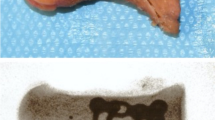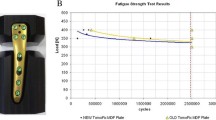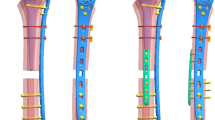Abstract
Purpose
An important disadvantage of the standard medial closing-wedge distal femur osteotomy for lateral compartment osteoarthritis of the knee is the immediate effects on the extensor mechanism function. Therefore, a novel bi-plane osteotomy technique was developed. The stability and stiffness of this newly developed technique and a modification of the proximal screw configuration were tested in a composite femur model and compared to the standard single-plane technique. Research question was if the new bi-plane technique and/or modified screw configuration would improve the stability and stiffness of the construct.
Methods
In 12 femurs, motion at the osteotomy under axial and torsion loading was measured using a 3D motion analysis system. All were subsequently tested to failure. The data recorded were used to calculate stability and stiffness of the constructs.
Results
The stability and stiffness were highest in the bi-plane technique under axial loads, but were lower under torsional loading, compared to the single-plane technique. The screw configuration modification improved axial stability and stiffness, but had no influence on torsional stability.
Conclusion
In replicate femurs, the new bi-plane technique improved axial stability, but in contrast to what was theorized, decreased torsional stability, compared to the single-plane technique. The addition of a bi-cortical screw proximally improved stability under axial loading, but not torsion. Further clinical testing will have to prove if early full weight bearing using the new bi-plane technique is possible.







Similar content being viewed by others
References
Agneskirchner JD, Freiling D, Hurschler C, Lobenhoffer P (2006) Primary stability of four different implants for opening wedge high tibial osteotomy. Knee Surg Sports Traumatol Arthrosc 13:291–300
Brinkman JM, Lobenhoffer P, Agneskirchner JD, Staubli AE, Wymenga AB, van Heerwaarden RJ (2008) Osteotomies around the knee: patient selection, stability of fixation and bone healing in high tibial osteotomies. J Bone Joint Surg Br 90:1548–1557
Brinkman JM, Luites JW, Wymenga AB, van Heerwaarden RJ (2010) Early full weight bearing is safe in open-wedge high tibial osteotomy—RSA analysis of postoperative stability compared to delayed weight bearing. Acta Orthop 81:193–198
Brinkman JM, Hurschler C, Agneskirchner JD, Freiling D, van Heerwaarden RJ (2010) Axial and torsional stability of supracondylar femur osteotomies: biomechanical comparison of the stability of five different plate and osteotomy configurations. Knee Surg Sports Traumatol Arthrosc. doi:10.1007/s00167-010-1281-3
Franco V, Cipolla M, Gerullo G, Gianni E, Puddu G (2004) Open wedge osteotomy of the distal femur in the valgus knee. Orthopade 33:185–192
Freiling D, Van Heerwaarden RJ, Lobenhoffer P (2007) Femurosteotomien: Wann muss ich an das Femur? Orthopädische Praxis 43:136–142
Freiling D, Lobenhoffer P, Staubli A, van Heerwaarden RJ (2008) Die varisierende schlieβende Femurosteomie zur Behandlung der Valgusarthrose am Kniegelenk. Arthroskopie 21:6–14
Freiling D, van Heerwaarden R, Staubli A, Lobenhoffer P (2010) Die varisierende closed-wedge Osteotomie am distalen Femur zur Behandlung der unikompartimentalen lateralen Arthrose am Kniegelenk. Medial closed-wedge osteotomy of the distal femur for the treatment of unicompartmental lateral osteoarthritis of the knee. Oper Orthop Traumatol 22:317–334
Healy WL, Anglen JO, Wasilewski SA, Krackow KA (1988) Distal femoral varus osteotomy. J Bone Joint Surg Am 70:102–109
van Heerwaarden RJ, Wymenga AE, Freiling D, Lobenhoffer P (2007) Distal medial closed wedge varus femur osteotomy stabilized with Tomofix plate fixator. Oper Tech Orthop 17:12–21
van Heerwaarden RJ (2008) Supracondylar varization osteotomy of the femur with plate fixation. In: Lobenhoffer P, van Heerwaarden RJ, Staubli AE, Jakob RP (eds) Osteotomies around the knee. Georg Thieme Verlag, Stuttgart, pp 147–166
van Heerwaarden RJ, Brinkman JM, Hurschler C (2010) Superior axial stability of a new biplane osteotomy technique for supracondylar femur osteotomies fixed with an angular stable plate. Knee Surg Sports Traumatol Arthrosc 18 (suppl 1): SCP10–1068
Heiner AD, Brown TD (2001) Structural properties of a new design of composite replicate femurs and tibias. J Biomech 34:773–781
Hsu RW, Himeno S, Coventry MB, Chao EY (1990) Normal axial alignment of the lower extremity and load-bearing distribution at the knee. Clin Orthop Relat Res 255:215–227
Luo CF (2004) Reference axes for reconstruction of the knee. Knee 11:251–257
Marti RK, Schroeder J, Witteveen A (2000) The closed wedge varus supracondylar osteotomy. Oper Tech Sports Med 8:48–55
Mathewson PR, Greenwald RM (2003) Reduction in anterior cruciate ligament load and tibiofemoral rotation under applied axial rotation: a surrogate model study of the efficacy of a new knee derotation brace concept. JPO 15:1–8
Miniaci A, Grossmann SP, Jakob RP (1990) Supracondylar femoral varus osteotomy in the treatment of valgus knee deformity. Am J Knee Surg 3:65–73
Szivek JA, Weng M, Karpman R (1990) Variability in the torsional and bending response of a commercially available composite “femur”. J Appl Biomater 1:183–186
Takeuchi R, Aratake M, Bito H, Saito I, Kumagai K, Ishikawa H, Akamatsu Y, Sasaki Y, Saito T (2008) Simultaneous bilateral opening-wedge high tibial osteotomy with early full weight-bearing exercise. Knee Surg Sports Traumatol Arthrosc 16:1030–1037
Takeuchi R, Ishikawa H, Aratake M, Bito H, Saito I, Kumagai K, Akamatsu Y, Saito T (2009) Medial opening wedge high tibial osteotomy with early full weight bearing. Arthroscopy 25:46–53
Wang JW, Hsu SS (2005) Distal femoral varus osteotomy for osteoarthritis of the knee. J Bone Joint Surg Am 87:127–133
Wojtys EM, Loubert PV, Samson SY, Viviano DM (1990) Use of a knee-brace for control of tibial translation and rotation. A comparison, in cadavera, of available models. J Bone Joint Surg Am 72:1323–1329
Author information
Authors and Affiliations
Corresponding author
Additional information
An erratum to this article can be found at http://dx.doi.org/10.1007/s00167-011-1450-z
Rights and permissions
About this article
Cite this article
Brinkman, JM., Hurschler, C., Staubli, A.E. et al. Axial and torsional stability of an improved single-plane and a new bi-plane osteotomy technique for supracondylar femur osteotomies. Knee Surg Sports Traumatol Arthrosc 19, 1090–1098 (2011). https://doi.org/10.1007/s00167-010-1349-0
Received:
Accepted:
Published:
Issue Date:
DOI: https://doi.org/10.1007/s00167-010-1349-0




